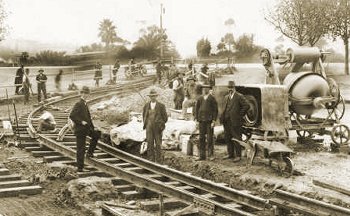Melbourne Tram Museum
- Follow Melbourne Tram Museum on Twitter
- Follow Melbourne Tram Museum on Facebook
- Follow Melbourne Tram Museum on Instagram
- Follow Melbourne Tram Museum on Pinterest
- Follow Melbourne Tram Museum on Tumblr
- Subscribe to Melbourne Tram Museum's RSS feed
- Email Melbourne Tram Museum
Fares please! An economic history of the Melbourne & Metropolitan Tramways Board
Debt-driven survival
So why did the Melbourne tramways survive the anti-tram sentiment of the 1950s and 1960s?
Very simply, the State Government could not afford to write off the investment in the tram system, as it would have needed to depreciate fully infrastructure worth in excess of 25 million dollars, as well as covering the outstanding loan liability of the Board.
To a large degree the Board’s survival was the result of the original legislation enabling the Board requiring it to maintain a generous sinking fund for realistic depreciation provisions. Therefore the M&MTB could maintain its assets in good condition as a result of this conservative financial management strategy. In contrast, the Sydney tramway system made no such provisions. During the boom years of the 1940s, when the M&MTB was making profits due to record patronage, the Sydney system was making a loss on every passenger, as its worn out rolling stock and infrastructure required excessive maintenance to cope with the wartime traffic increases. Therefore, despite record revenues and patronage, the Sydney tramways became more run-down with no financial reserves to remedy the situation when peace returned.
 Tramway construction, Burwood Road Hawthorn, 13 May 1925.
Tramway construction, Burwood Road Hawthorn, 13 May 1925. - Photograph courtesy State Library of Victoria.
In effect, the Melbourne tram system was at least 20 years newer than
those Australian tramways [31] that closed during
the post war decades, as a result of it largely being converted from
the cable tram system or built new during the inter-war period. This
fact, and the result that the network was not fully depreciated, meant
that it would survive to the 1970s – when the pendulum of popularity
began to move away from the private motor vehicle towards a more balanced
approach to urban transport.
Footnote
[31] Australian tramways closed post-World War 2 were:
- 1950 – Newcastle (NSW)
- 1952 – Kalgoorlie (WA), Fremantle (WA), Launceston (Tas)
- 1956 – Geelong (Vic), Sandringham-Black Rock (Vic)
- 1958 – Adelaide except Glenelg line (SA), Perth (WA)
- 1959 – St Kilda-Brighton Beach (Vic)
- 1960 – Hobart (Tas)
- 1961 – Sydney (NSW)
- 1969 – Brisbane (Qld)
- 1971 – Ballarat (Vic)
- 1972 – Bendigo (Vic)